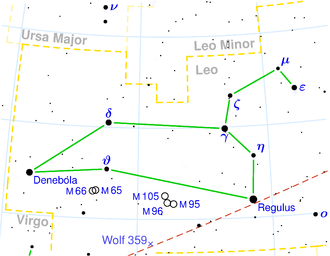IC 2650
| Galaxy IC 2650 |
|
|---|---|

|
|
| AladinLite | |
| Constellation | lion |
|
Position equinox : J2000.0 , epoch : J2000.0 |
|
| Right ascension | 11 h 14 m 52.6 s |
| declination | + 13 ° 51 ′ 09 ″ |
| Appearance | |
| Brightness (visual) | 15.2 mag |
| Brightness (B-band) | 16.0 mag |
| Angular expansion | 0.4 ′ × 0.4 ′ |
| Surface brightness | 13.1 mag / arcmin² |
| Physical data | |
| Redshift | 0.067399 ± 0.000144 |
| Radial velocity | 20,206 ± 43 km / s |
|
Stroke distance v rad / H 0 |
(899 ± 63) · 10 6 Lj (275.7 ± 19.3) Mpc |
| diameter | 100,000 ly |
| history | |
| discovery | Max Wolf |
| Discovery date | March 27, 1906 |
| Catalog names | |
| IC 2650 • PGC 1442333 • 2MASX J11145254 + 1351086 • GALEX ASC J111452.71 + 135109.1 | |
IC 2650 is a spiral galaxy from the Hubble type S in Leo on the ecliptic . It is estimated to be 899 million light years from the Milky Way and about 105,000 light years in diameter . The galaxy is characterized by two extended spiral arms .
The galaxies IC 2657 , IC 2661 , IC 2666 , IC 2695 are located in the same area of the sky .
The object was discovered by Max Wolf on March 27, 1906 .
